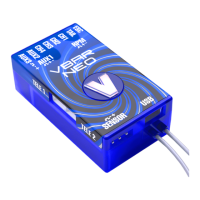9
☝ Attention Keep your touchscreen display clean. Use a soft
cloth and only non-aggressive detergents to clean it. Hard or
abrasive foreing particles may scratch the glass surface.
☠ Danger When setting up your radio, make sure you do not
assign two vital functions to the same switch, e.g. Motor
Switch, Safety Switch (optional) and Throttle Cut (Motor Off
on IC powered models), they must be set to independent
switches.
☝ Attention Familiarize yourself with the switch assignment,
especially with Motor Off, so you ip the proper switch even
in case of an emergency (e.g. loss of control). Do as safe
test run on the ground, without main and tail rotor blades,
propellers, wheels, to familiarize yourself with the operation
of the model, and check the action of the governor/ESC. If
your are setting up an IC powered model, check the action
of the throttle servo and the carb when switching the sever-
al states of the Motor Switch and when actuating the Throt-
tle Cut switch.
☝ Attention Before any radio control operation, check the
following:
» Are the batteries charged fully/sufciently?
» Is there enough fuel in the tank?
» Are any liquids spilled on the electronics, like water or fuel?
» Make sure all linkages are secure and no slop or binding
occurs in operation.
» Make sure that the overall vibration level on the model is
low, and that all control functions work reliably when the
power unit and drive train are running at the expected rpm.
» Make sure all fail safe precautions are met: in case of a
loss of control the motor/engine must turn off.
» When running the power unit/drive train, keep clear of
rotating parts and mind the danger of main or tail rotor
blades, propellers or wheels spinning.
» On the rst operation of a newly set up model, select a
safe place for takeoff, landing or driving, and test the
control functions and operation close by but at a safe
enough distance for several minutes. Do not test at dis-
tances too far away.
» Familiarize yourself with safety precautions, such as how
to switch off the motor in case of any unwanted/uncon-
trolled operation. This is to take the energy and vibration
out of the system. Be prepared to attempt an emergency
landing/autorotation.
☝ Attention VBar Control will warn if the battery level falls
below 3.5 V. VBar Control will switch off automatically when
the battery level falls below 3.2 V except when a model is
connected (safety feature).
As a safety measure, the touchscreen display will eventual-
ly power down in a low battery situation, to save energy for
the radio control operation.
Land immediately and turn off the model/stop opera-
tion of your model, if a battery warning occurs.
■ Take special care with the following to prevent unwant-
ed heat generation, re and explosion.
☠ Danger Use only the supplied wall charger with the appro-
priate adapter. Check the voltage in the country you are in,
it must not exceed 100-240 V AC.
» Do not misconnect (+) and (–)
» Do not place VBar Control or the charger next to heat or
open re.
» Keep open terminals (+) and (–) away from conductive
materials like metal surfaces, carbon bre, tools.
» Never disassemble or modify VBar Control beyond what
is described in this manual, and never use a soldering
iron on the electronics.
☠ Danger Never use batteries other than those sold by
Mikado Model Helicopters. The batteries have been care-
fully selected and adapted for use in VBar Control. Always
monitor the charging process, even though the integrated
charging circuit takes care of the proper charging parame-
ters. Stop the charging process immediately if the device
gets hot.
» Never allow the battery to have any contact with liquids.
» Never damage the insulation, connecting wires, connec-
tors.
» Stop using a battery that has taken damage to the insu-
lation, connecting wires, connectors.
» Battery liquids are dangerous. If your eyes, skin or
clothes come in contact with these, rinse thoroughly and
wash your clothes with clean water.
» Always monitor the condition of your batteries by check-
ing the operating time and charging time. When operat-
ing times or charging times start to differ strongly, the
end of a battery’s lifetime may have come.
» Battery failure may cause your model going out of con-
trol, causing dangerous situations.
☝ Attention Never store your VBar Control and the battery in
high temperature, or in very dusty or very humid conditions.
» Store the VBar Control and the battery outside of the
reach of infants and children.
» Never charge the battery of your VBar Control in very
cold conditions (lower than 0 °C/32 °F).
» A used Lithium Polymer battery is not domestic waste. To
dispose of a Lithium Polymer battery, discharge the bat-
tery, insulate the terminals with tape. Then take it to a
store/dealer who can dispose of small rechargeable bat-
teries, or take it to a collection point for harmful substanc-
es.
» Never keep the VBar Control in direct sunlight for an ex-
tended time. Keep it in the shadow when it is not used.

